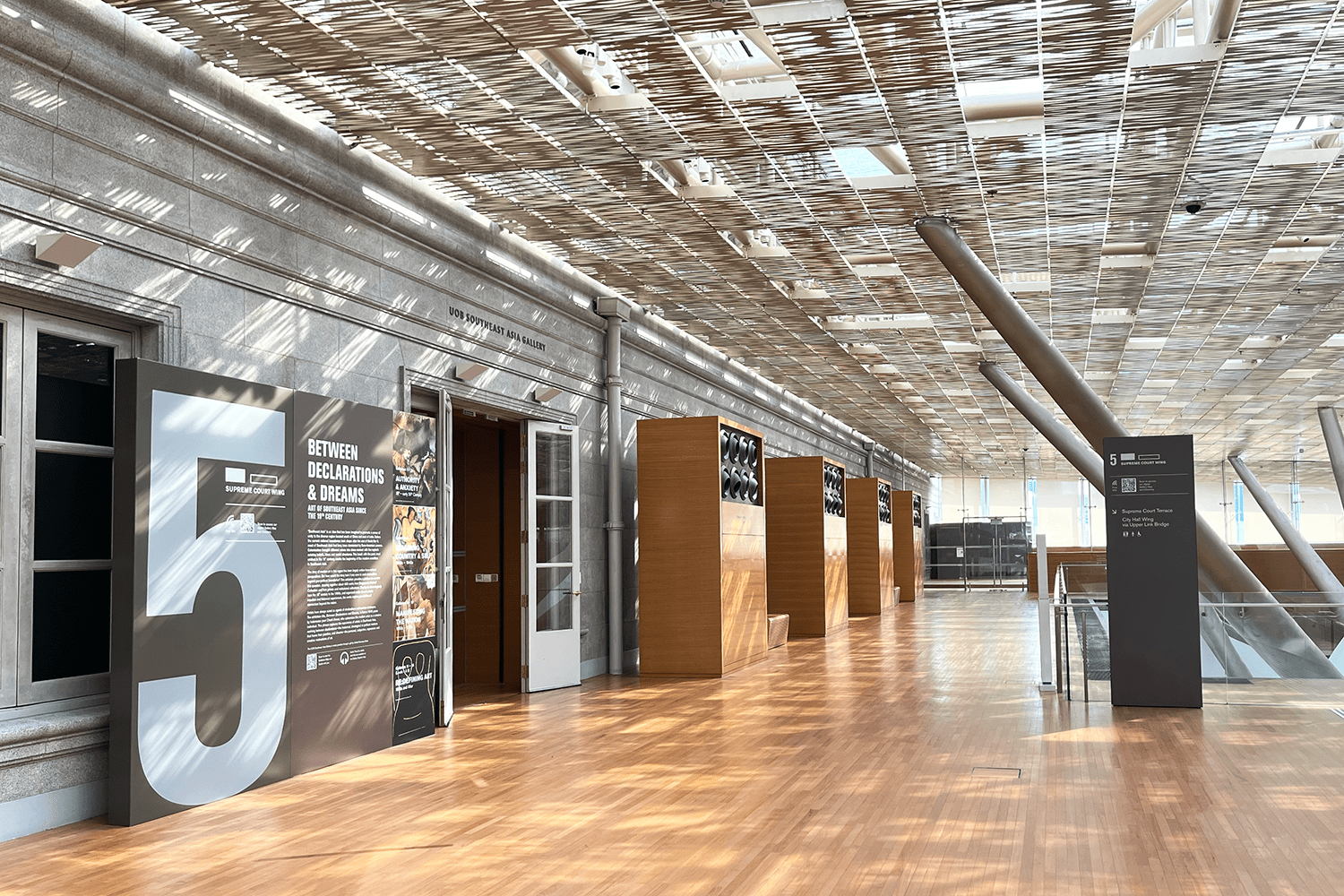Wayfinding System Design for National Gallery Singapore
The National Gallery Singapore’s architecture is comprised of 2 heritage buildings. A newly built basement and an atrium space connects these 2 buildings, creating a unique blend of old and new. However, this also provides an interesting challenge in way-finding and the 2 heritage buildings were previously a city hall and a supreme court, not an art museum.
Scope of Work
Project period (where I was involved): Jan 2020 – Aug 2021
2 Key challenges
From the surveys and interviews conducted, the major challenges with way finding in the gallery can be grouped into 2 categories:
Spatial or architectural challenges due to the original designs of the heritage buildings not being designed for a museum experience. For example, there were a lot of similar looking corridors, hallways and rooms with multiple doors.
Changing exhibitions leading to changes in the desired visitor flows and routes throughout the building. Temporary exhibitions can take up as little as 3 gallery rooms in a single floor or as much as many gallery rooms across multiple levels.
The 2 heritage buildings make up the 2 wings of the museum. These 2 wings are connected by the newly built basement 1, level 1 atrium, and 2 bridges at levels 3 and 4.
When a logo mark becomes a way finding device
One major visitor pain point is that visitors do not know that the museum is made up of 2 buildings (Wings). Coincidentally, the museum’s logo mark is a graphic representation of the 2 heritage buildings. So we incorporated the museum’s logo mark into the directory and signage layout design. This visual gesture also indirectly helps visitors appreciate the story behind the museum’s branding and heritage.
The Wayfinding System Main Kit of Parts
Large Level Numbers as Visual Landmarks
Large numbers are used to indicate the levels that users are on to create a visual landmark that users can easily remember. These also serves as visual anchors when users feel lost and need to re-orientate themselves, such as when entering a new level after staircases or escalators.
Exhibition Posters as Way Finding Device
These are exhibition-specific posters that serve as directional signage that guides users to exhibition entrances. These posters utilise key visual or colour from the exhibition’s idenitity so they function like visual breadcrumbs leading users to the exhibition that they wish to see. I created a template and thorough guidelines on how to create these posters that the internal design team can use for future exhibitions.
Detailed design and best practices guidelines were provided for the museum’s internal teams The internal teams should be able to create final art to fit each of the poster locations.
Design templates and detailed guidelines were provided for the museum’s internal team.
The simplified poster signage is applied along narrow corridors, to avoid visual clutter in the museum.
Directional Signage System
These are more conventional and permanent signage users can use to navigate towards fixed spaces in the museum. These are placed at 3 strategic types of locations:
Near stairs and escalators - to indicate what’s available in the next level
Nodal points - these are decision making points (or confusion points) which occurs often in the museum
Reassurance points - these are long hallways that all look the same architecturally, users typically feels unsure when going through these spaces.
Due to budget, we aimed to repurpose as many of the original signage as possible. We focused instead on the layout, content hierarchy and legibility of the signage. This is important due to the complexity of the building. After an audit of the existing signage, we decided to keep the new design very simple, clean uncluttered. due to the complexity of the information on the signage, the focus is functionality.
An audit of an existing signage design and layout.
A content hierarchy for all the visitor-facing locations in the museum.
We established a hierarchy for all visitor-facing locations in the museum. This become the master guideline for how the content for all signage, maps and directories are laid out. For instance, exhibition areas should be prioritised over restaurants, so the first lines of the signage should direct users to the exhibition areas first.
Spatial challenges when designing the physical signage system and final art files:
Varying spatial conditions where these signage need to be placed, such as different ceiling heights.
Different environmental conditions, such as historical marble walls vs painted walls,
Non-existent wall space in some locations
Some areas are considered national heritage areas, and as such we were not allowed to do anything to the walls, ceilings and floors of these spaces.
Almost half of the building is considered heritage areas.
The use of bright colours in these areas are also restricted as they alter the overall ambience of the heritage areas.
Digital Directories at Lift Lobbies
These are digital directories placed at lift lobby, highlighting key exhibitions and popular destinations at each floor. The content on these are synced to the museum’s CMS so every time a new exhibition is showing, these directories will be updated automatically.
Content and layout guide for the digital directory









